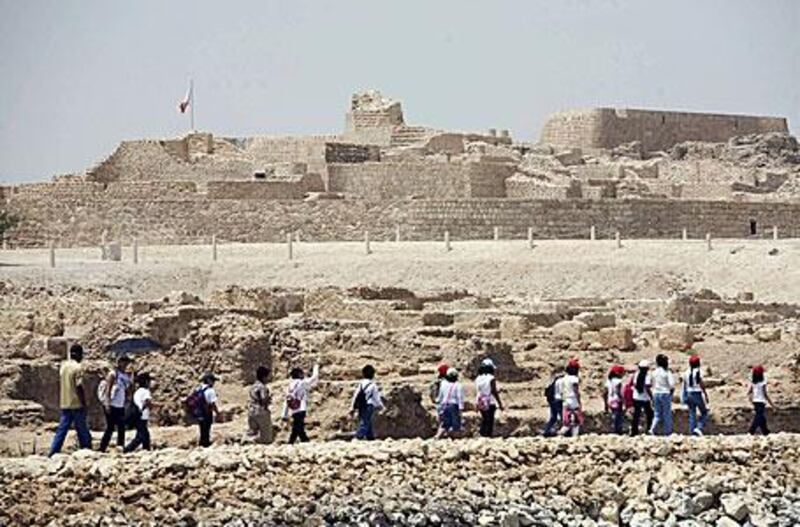MANAMA // They are the remnants of one of the most important ancient civilisations in the Gulf; a series of Bronze Age burial mounds that once stretched for kilometres across Bahrain in sand-coloured waves. While urban development has destroyed about 80 per cent of the roughly 75,000 graves, a campaign to save the rest is gaining pace in the kingdom as the ministry of culture tries to buy back the land from private developers and Bahrainis become aware of their heritage.
"The most important sites in Bahrain are these burial mounds," said Salman al Mahari, an archaeologist and member of a national committee that is drafting a proposal to put 11 sites, covering the 12,000 or so remaining burial mounds, on a Unesco world heritage list which would protect them from further development. The first tombs were excavated in the 1950s, but the campaign to protect them has only taken off in the last few years.
"I am going to people in the villages where there are archaeological sites, talking to people, taking them to these sites and telling them how important are these and why we should protect them." Many of the graves date from the Dilmun civilisation, which was at the crossroads of the ancient world and reached its zenith from 2050BC to 1800BC and may have spread as far as eastern Saudi Arabia, Kuwait, Oman and parts of the Emirates.
The ministry of culture and information, under Sheikha Mai bint Mohammed Al Khalifa, has so far bought five of the 11 plots with the view to preserve, excavate and most likely turn them into tourism sites. "We're working to purchase them; it's the best way to preserve them. It will cost us millions. It is not a small site or one house, it is big fields, but we are optimistic," Mr al Mahari said.
The Dilmuns were a seafaring people who prospered as middlemen, trading goods such as wool, silver and garlic between Mesopotamia and the Indus, part of modern Iraq and Pakistan, respectively. They buried their dead in the fetal position, surrounded by personal belongings such as pots and daggers to help them in their journey to the afterlife, and placed them inside rounded structures covered with sand, the average height of which was 1.5 metres. Royals were buried with exquisite treasures, although few of these survived due to looting.
Expensive, sprawling villas and apartment buildings have been built over many of the burial grounds and the developments bump up alongside surviving ones, giving their residents bedroom views of Bronze Age graves. Very little is known about the Dilmuns because only a small number of the graves have been excavated, said Nadine Boksmati-Fattouh, the director of the museum at the Qalaat al Bahrain site which, together with an ancient harbour, was the Dilmun capital.
"We don't know what language they spoke or where they came from. Some say they were nomads, or a further theory is that Phoenicians came to die here from Lebanon, that this island was a large cemetery. This is one of the main controversies. We're trying to show that Dilmun, or at least Bahrain, was not a cemetery. There was a succession of cities. It was alive." The capital was said to have been a bustling metropolis with wide streets and architecturally impressive buildings, the likes of which were not seen again in the Gulf until the arrival of the Islamic period.
"It's very politicised, the protection of the tombs," said Ms Boksmati-Fattouh. "Some can't understand why they can't build houses. Some don't understand the importance of it. You can't force everyone to understand the importance of heritage. Still, it is better here than other parts of the Arab world." In Lebanon, for example, the debate between development and preserving cultural relics has divided the Lebanese since the end of the 15-year civil war in 1990 which destroyed most of Beirut.
Rafiq Hariri, the billionaire businessman and former prime minister assassinated in 2005, was praised by some for bringing commerce to downtown Beirut but the destruction of palm-lined squares, covered Ottoman souqs and old French buildings led some critics to dismissively call the capital "Canary Wharf on the Mediterranean" in reference to the modern business area of London. Bahrain has another pressing problem: population growth.
The kingdom has 1.1 million residents and is growing at an annual rate of 1.2 per cent. There is already a severe shortage of decent government housing - there were about 40,000 people on a waiting list last year - with many in the poorer villages living in derelict buildings. About 100 kilometres of coastline has been reclaimed since the 1980s as the government tries turn the kingdom into a commercial and financial hub and Mr al Mahari said the government should use this to build housing, rather than destroying the country's heritage.
"There are many empty places in Bahrain, especially in the southern part, and there is a lot of reclamation of the sea," said Mr al Mahari. "So these will give additional land to housing. "I don't think the only way to do housing is to remove archaeological sites. It is not the right way. We have reclaimed a lot of land from the sea." The Dilmun people left no written records, but one of the few clues which attests to Bahrain as a financial hub of the ancient world is the curious seals which have been found in the burial sites. Carved out of soft, dark green chlorite or steatite, the seals were used as signatures on contracts and on labels attached to goods or property.
"Our main evidence of who they were are the seals," said Ms Boksmati-Fattouh. They were also an art form. One shows a lion with open jaws attacking an antelope, its ears held back by two monkeys. After 1750BC the civilisation went into decline. Alexander the Great's armies arrived and later on the Islamic conquerors, all of whom also buried their dead in similar mounds. The graves are a testament to 4,000 years of Bahrain's history.
But by the mid-20th century the Dilmuns had disappeared from the collective memory of the islanders. When the kingdom started to make its transition from empty desert to a modern metropolis, nearly all the land was partially or wholly sold to private companies for development. "Before the 1950s the Bahrainis had no idea about Dilmun," said Ms Boksmati-Fattouh. "We heard about them from ancient Sumerian texts. That was the first evidence. They said the Dilmun land was where the sun rises and it was paradise on earth. But only in the 1950s Danish archaeologists arrived and found the tangible evidence."
In recent years however, attitudes have begun to change. At the moment Unesco has put the burial mounds on its "tentative list", which means Bahrain has to gain control of the sites before the UN body will grant them world heritage status. And there is a moratorium on development, Mr al Mahari said. "I say to whose who are interested in money, these are commercially important because we can use them as tourism sites. They can attract money and investors," he said. "If they are interested in these places for cultural reasons, we say this is our history. We cannot live without our history."
hghafour@thenational.ae





